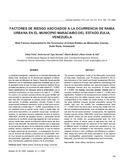Mostrar el registro sencillo del ítem
Factores de riesgo asociados a la ocurrencia de rabia urbana en el municipio Maracaibo del estado Zulia, Venezuela
| dc.rights.license | http://creativecommons.org/licenses/by-nc-sa/3.0/ve/ | |
| dc.contributor.author | Prieto, Yelitza | |
| dc.contributor.author | García G., Arelis | |
| dc.contributor.author | Sánchez, Edgar | |
| dc.contributor.author | Medina, Alberto | |
| dc.contributor.author | Oviedo de Vale, María G. | |
| dc.date.accessioned | 2009-05-25T15:23:44Z | |
| dc.date.available | 2009-05-25T15:23:44Z | |
| dc.date.issued | 2009-05-25T15:23:44Z | |
| dc.identifier.issn | 0798-2259 | |
| dc.identifier.uri | http://www.saber.ula.ve/handle/123456789/28438 | |
| dc.description.abstract | La presente investigación, realizada en el Municipio Maracaibo del estado Zulia, Venezuela, en 76 caninos que ingresaron al laboratorio de rabia del Ministerio de Salud y Desarrollo Social permitió determinar con la metodología estadística empleada que no existe asociaron entre el sexo, la edad y la tenencia (dueños) de los animales estudiados y la ocurrencia de rabia urbana (P > 0.005); fueron significativos los hallazgos entre la enfermedad con la condición inmunitaria y el libre acceso a la calle (P < 0.005). En cuanto a la variable socioeconómico del grupo familiar del cual procede la casuística de rabia se encontró que la positividad más alta correspondió al estrato social medio bajo. En este sentido, el análisis estadístico utilizado (prueba Z para proporciones) evidenció asociación entre el nivel socio económico medio alto y medio bajo (P <0.005), encontrándose el mismo resultado entre el estrato social medio y bajo, así como entre el último y la condición social baja. Consecuenteme, la casuística humana registrada durante el decenio 1995 – 2004, procede de aquellos barrios y parroquias donde predomina la condición social baja seguida del nivel socioeconómico medio bajo, siendo la población infantil menor de doce años la más afectada. Se determinó también que la respuesta de los servicios de salud en los diferentes niveles de decisión política, táctica y operativa no es oportuna, lo que se traduce en bajas coberturas de vacunación. La investigación de los focos en términos de eficacia y eficiencia es cuestionable, siendo muy escasa la participación activa de los organismos gubernamentales regionales y municipales (gobernación, alcaldías, intendencias y jefaturas civiles) y de la comunidad. | es_VE |
| dc.rights | info:eu-repo/semantics/openAccess | |
| dc.subject | Rabia urbana | es_VE |
| dc.subject | Factores de riesgo | es_VE |
| dc.subject | Zoonosis | es_VE |
| dc.title | Factores de riesgo asociados a la ocurrencia de rabia urbana en el municipio Maracaibo del estado Zulia, Venezuela | es_VE |
| dc.title.alternative | Risk factors associated to the ocurrence of urban rabies on Maracaibo county, Zulia state, Venezuela | es_VE |
| dc.type | info:eu-repo/semantics/article | |
| dc.description.abstract1 | The present investigation, made at the Maracaibo municipality of Zulia state, Venezuela, over 76 canines admitted in the rabies laboratory of the rage of the Health and Social Development Ministry, of allowed to determine through used statistical methodology that there is not association between sex, age and property (owner) of evaluated animals and the occurrence of urban rabies (P > 0.005); the disease outcomes between disease and immunitary conditions and free access to street (P < 0.005) were Significative. Related to the socioeconomic variable of the familiar group from the rabies casuistic come, the high positividad corresponding to the middle low social stratus. In this sense, the used statistical analysis showed association among the middle high and middle low socialeconomical (P < 0.005) found the same result among the middle and middle low socialeconomical levels, such as between the same result and the low social condition. Consecuently, the registered human casuistry during 1995 - 2004, comes fro neighborhoods and parish where the low social condition predominant, followed for the middle low socialeconomical level: the child population below of twelve years of age were the most affected. It was determined the response of the health services at different levels of political, tactical and operative is not opportune, which is translated in low vaccination covering. The research of focus in terms of efficacy and efficiency is questionable, being very scarce the active participation of the regional and municipalities governmental organisms (Government, mayoralty, City hall and Civil headquarters) and of the community. | es_VE |
| dc.description.colacion | 165 - 175 | es_VE |
| dc.description.email | aregarcia@luz.edu.ve | es_VE |
| dc.description.frecuencia | Bimestral | |
| dc.identifier.depositolegal | 199102ZU46 | |
| dc.subject.institucion | Universidad del Zulia (LUZ) | es_VE |
| dc.subject.institucion | Universidad de Los Andes (ULA) | es_VE |
| dc.subject.keywords | Urban rabies | es_VE |
| dc.subject.keywords | Risk factors | es_VE |
| dc.subject.keywords | Zoonosis | es_VE |
| dc.subject.publicacionelectronica | Revista Científica | |
| dc.subject.tipo | Revistas | es_VE |
| dc.type.media | Texto | es_VE |
Ficheros en el ítem
Este ítem aparece en la(s) siguiente(s) colección(ones)
-
Revista Científica - 2006 - Vol XVI - No. 002
Marzo - Abril 2006



